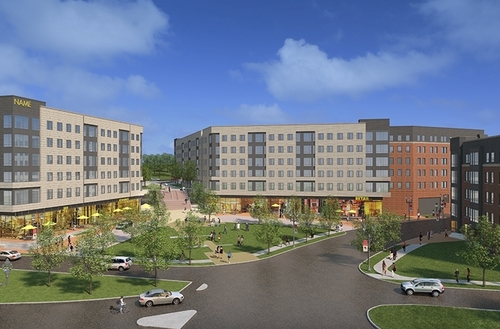An entire student neighborhood bites the dust in College Park
New investment is pouring into College Park, seeking to turn this town known for undergrads and traffic into an urban hub for all ages. As part of that transformation, the famous Knox Boxes student neighborhood is transforming from the ground up.
For decades, the Knox Boxes epitomized the University of Maryland’s image as a party school. The cluster of 25 low-rise 1950s-era brick apartment buildings was just south of the campus, behind the seedy bars and pizza joints on Route 1.
For many undergrads, a Knox Box apartment was their first taste of living on their own, and the small backyards and proximity to other neighbors made for comfortable college living.
But they were also cheaply built and poorly maintained. During my freshman year at Maryland, two students died in separate Knox Box fires.
As Maryland became known more for academics than basketball riots, the university and the City of College Park started looking at ways to redevelop the Knox Boxes.
Getting multiple landlords to sell was difficult, but by 2013, a single owner had purchased most of the Knox Boxes. That year, the city approved a plan from developer Toll Brothers, usually known for suburban McMansions, to replace the Knox Boxes with Knox Village, a luxury student apartment complex for over 1,500 students.
Like most of the new student housing going up in College Park, Knox Village’s apartments and townhomes will have gourmet kitchens and amenities like a pool, gym, and covered parking garage. The complex will have a series of courtyards with a grand staircase (which Toll Brothers compares to the Spanish Steps in Rome…), and two spaces for shops and restaurants.
Mayor Andy Fellows called the vote a “landmark occasion.” Construction began last summer, though a few of the Knox Boxes whose owners didn’t sell remain.
Change in College Park goes well beyond the Knox Boxes
Knox Village is just one piece of a bigger plan to recast College Park as more of a college town, hoping to attract post-graduates or even families. The university and the city recently opened a charter school to keep more faculty in the area. In a reversal from 10 years ago, when the administration opposed the Purple Line running through campus, president Wallace Loh has been a strong supporter.
More high-end student apartments are going up on Route 1, and last week Target announced plans to open one of the nation’s first Target Express stores inside one of them. The university itself has been buying up properties in downtown College Park, and they’re partnering with developer U3 Advisors to buy a former bar and turn it into a branch of Milkboy, a Philadelphia music and art venue. Even Ratsie’s Pizza, a longtime favorite of the drunk and hungry, will become a Nando’s Peri-Peri.
Not even six years since I graduated from Maryland, much of College Park is unrecognizable. Having lived on Knox Road as an upperclassman, I admit I’m a little nostalgic about losing the Knox Boxes. It’s also worrisome that so much of the new student housing is very expensive and might make the already high cost of attending college even higher. On the other hand, thousands of new student apartments are coming in, and as the supply increases, rents are likely to fall.
When I lived there, College Park could be frustrating if you weren’t into the party scene. There wasn’t even a grocery store within walking distance of campus. It’s exciting to see College Park develop into more of a college town. That’s not only great for students and faculty, but also for neighbors who aren’t even affiliated with the university.
Check out these photos of the Knox Boxes in 2006 and today.




